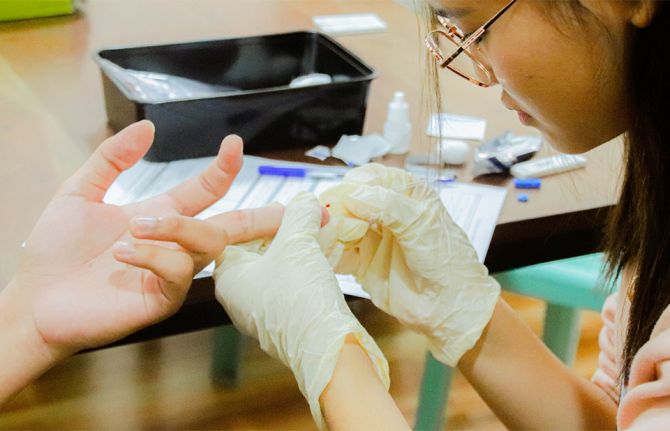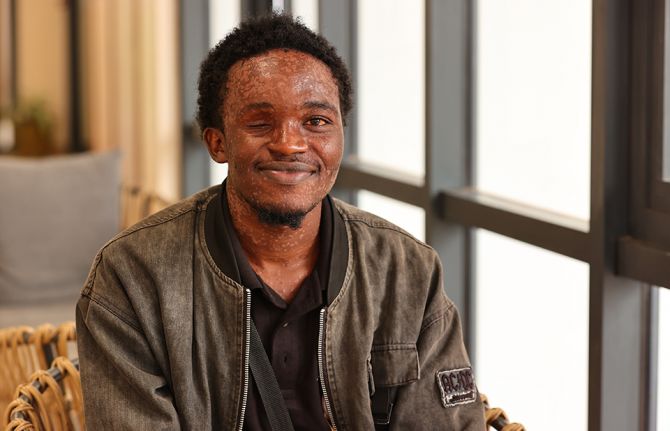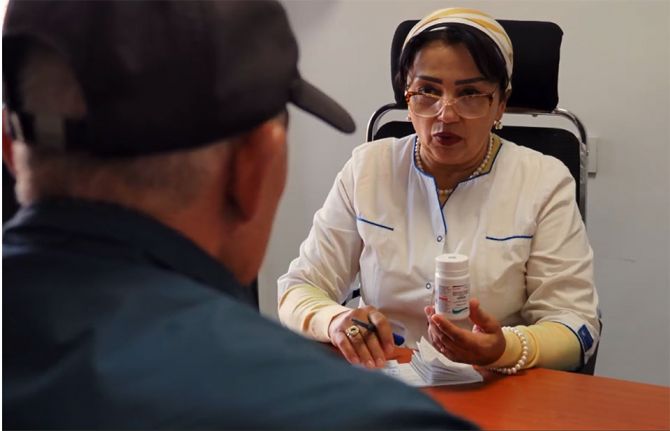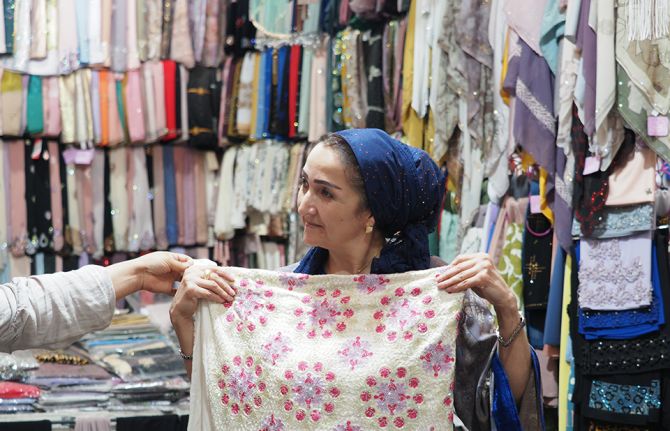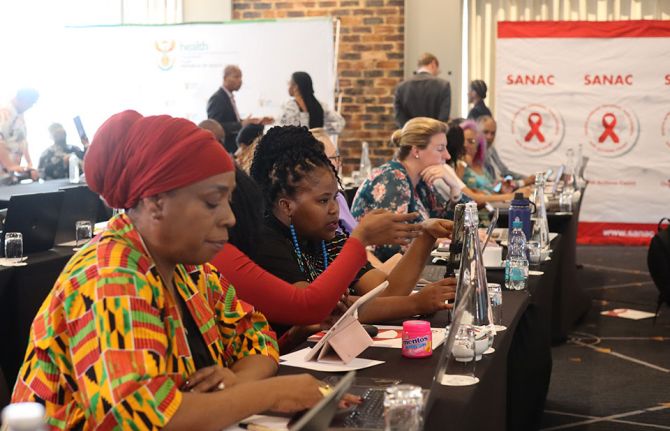

Press Release
President Félix Tshisekedi to Launch National Initiative to End Pediatric AIDS in the Democratic Republic of the Congo
10 June 2025 10 June 2025KOLWEZI, LUALABA PROVINCE, DRC, 9 June 2025 — On Friday, June 13, during the closing session of the Governors’ Conference in Kolwezi, Lualaba Province, His Excellency President Félix Tshisekedi will launch the Presidential Initiative to End Pediatric AIDS in the Democratic Republic of the Congo (DRC).
The launch of this bold initiative marks a renewed national commitment to addressing one of the most persistent and heartbreaking inequities in the country’s HIV response: children’s limited access to life-saving HIV treatment and prevention services.
Over recent decades, the DRC has made remarkable strides in rolling out HIV testing and treatment services nationwide. Today, an estimated 91% of adults living with HIV in the DRC are on antiretroviral therapy, thanks to strong collaboration between the government, civil society, affected communities, and key partners including PEPFAR, the Global Fund to Fight AIDS, Tuberculosis and Malaria, UNAIDS and its 11 co-sponsoring agencies, the Elizabeth Glaser Pediatric AIDS Foundation (EGPAF), the private sector, and others.
But progress for children has lagged behind. Only 44% of children living with HIV in the DRC currently receive treatment. This proportion has remained tragically low for a decade, with thousands of children still newly infected each year. These infections are mostly due to missed opportunities to test pregnant women, which would enable timely interventions to prevent mother-to-child transmission and keep mothers alive.
This gap underscores persistent challenges in the health system, including:
- Insufficient access to quality sexual and reproductive health services for women;
- Poor integration of HIV services within platforms for maternal, newborn, child, and adolescent health;
- A fragile supply chain for essential medical commodities;
- Weak community systems and limited coordination between community actors and public services.
The Presidential Initiative to End Pediatric AIDS is a call for urgent and sustained action. It demands greater political leadership and accountability from Governors and provincial authorities, emphasizing the need for local solutions to local challenges. The initiative aims to:
- Improve early HIV screening and quality of treatment for children, adolescents, and pregnant and breastfeeding women;
- Prevent new HIV infections among children and mothers;
- Ensure timely initiation of antiretroviral therapy for HIV-positive adolescents, pregnant and breastfeeding women;
- Eliminate structural barriers that limit access to HIV screening and services for adolescents.
The five-year initiative, backed by at least USD 18 million in domestic funding, will complement existing national programs and investments, mobilizing localized efforts and innovations to close the pediatric HIV treatment gap in every province.
“At a time when global development financing is shifting and placing pressure on the systems that support our most vulnerable, the leadership of President Félix Tshisekedi in launching this initiative is a beacon of hope. UNAIDS salutes the President’s leadership and stands in full support of this bold and inspirational agenda,” said Dr Susan Kasedde, UNAIDS Country Director in RDC.
UNAIDS
The Joint United Nations Programme on HIV/AIDS (UNAIDS) leads and inspires the world to achieve its shared vision of zero new HIV infections, zero discrimination and zero AIDS-related deaths. UNAIDS unites the efforts of 11 UN organizations—UNHCR, UNICEF, WFP, UNDP, UNFPA, UNODC, UN Women, ILO, UNESCO, WHO and the World Bank—and works closely with global and national partners towards ending the AIDS epidemic by 2030 as part of the Sustainable Development Goals. Learn more at unaids.org and connect with us on Facebook, Twitter, Instagram and YouTube.
Contact
UNAIDS DRCNgoy Mukulumpe Raoul
tel. +243 976000092
ngoym@unaids.org
UNAIDS WCA Regional office
Jeanne Seck
tel. +221 78 465 03 46
seckj@unaids.org
Region/country

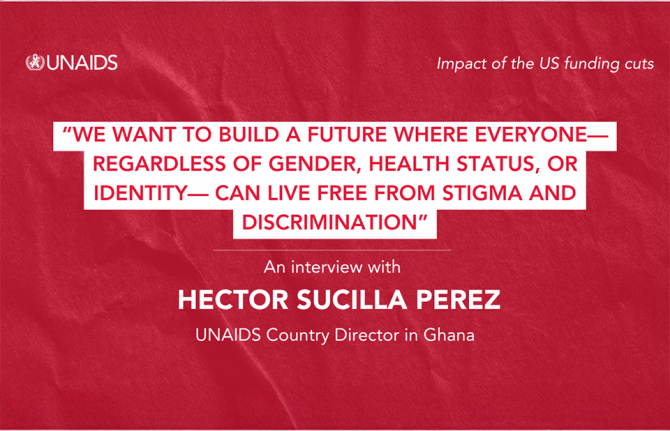
Feature Story
"We want to build a future where everyone—regardless of gender, health status, or identity—can live free from stigma and discrimination"
05 June 2025
05 June 2025 05 June 2025Ghana’s efforts to end AIDS has long relied on international support, particularly from the United States. Recent US funding cuts, however, have led to the suspension of critical programmes including human rights, raising concerns for key populations most affected by HIV-related stigma and discrimination.
In this interview, Hector Sucilla Perez, UNAIDS Country Director for Ghana, talks about the current state of the HIV response, the consequences of these funding changes, and the next steps for the country’s HIV response.
Q: What is the current state of Ghana’s HIV epidemic?
Ghana has an estimated 330 000 people living with HIV, with two-thirds being women aged 15 and over. In 2023 alone, there were 18 000 new infections and 12 000 AIDS-related deaths. The most affected groups are transgender women, men who have sex with men, female sex workers, and women. While new infections and deaths have decreased over the last decade, the reduction is far below expectations—only a 19% drop in new infections and 35% in deaths since 2010. The country needs to speed up more in the way we are decreasing new infections and deaths.
Ghana’s HIV response is heavily dependent on international donors. In 2022, Ghana's total expenditure on HIV and AIDS-related activities was approximately US$ 126 million. The Global Fund covers about 29% of this, PEPFAR (the US President’s Emergency Plan for AIDS Relief) about 8.5%, and the UN about 4.5%. PEPFAR support in Ghana has been essential and critical, investing more than US$ 204 million since 2007, mainly in HIV prevention, testing, treatment support, monitoring, and human rights work.
Q: What specific activities has PEPFAR been supporting in Ghana?
PEPFAR works in three regions of Ghana, (Western, Western North, and Ahafo), supporting essential catalytic services related to HIV prevention, including PrEP, as well as diagnosis, testing, treatment, and support services. They have also been supporting monitoring and evaluation to strengthen health information systems and improve data accuracy, which is critical for guiding our response.
Additionally, PEPFAR has been implementing human rights programmes with special emphasis on eliminating HIV-related stigma and discrimination. While they do not procure antiretroviral treatment in Ghana, they provide key technical assistance to the health sector on supply chain management for drugs and commodities.
Q: What has been the impact of the recent US funding cuts?
The initial pause in US government support affected activities in more than 120 healthcare sites across two regions, affecting 10 civil society organizations collaborating on PEPFAR-implemented programmes.
Some critical PEPFAR-supported actions were thereafter reinstated due to the waiver, particularly those related to the 95-95-95 targets, with a focus on vulnerable populations, especially adolescent girls and young women, and pregnant women. Monitoring, evaluation, data collection, and technical support for supply chain management were also reinstated.
However, strategic activities related to human rights with emphasis on stigma and discrimination, community-led monitoring, and interventions focusing on key populations have been definitively suspended. This represents a significant challenge for Ghana's HIV response.
Q: How is Ghana responding to these funding cuts, particularly regarding human rights programmes?
The government, through the Ghana AIDS Commission, has re-established and reinvigorated the Human Rights Stream Committee supported by UNAIDS and the Global Fund Grant. The Committee is currently to analyzing how the country can take over some of these activities. They are looking at integrating HIV more deeply into actions implemented by other government partners such as the Commission for Human Rights and Administrative Justice (CHRAJ), and increasing collaboration with the Ministry of Gender and Social Protection and the Ministry of Labour. UNAIDS provides technical assistance in support to these efforts.
We are also supporting CHRAJ to develop a handbook on stigma and discrimination through the lens of HIV, health and rights as a sustainable way of embedding continuous professional development in the work of this Government entity on actions focused to address HIV stigma and discrimination.
UNAIDS in Ghana is also strengthening community leadership particularly networks of PLHIV and key populations to play an important role in leading harmonized CLM initiatives in Ghana in collaboration with Global Fund implementers. This is by means of technical assistance and hands on support to communities to develop concrete priorities aligned to key data gaps, including stigma and discrimination and linkages to treatment adherence.
UNAIDS has also engaged with the Global Fund to explore using efficiencies in their grants to cover these activities. The Global Fund has shown willingness to potentially develop a strategy where all stakeholders can contribute to maintaining the most relevant human rights activities in Ghana.
Q: What new initiatives are being developed to address these gaps?
The UNAIDS country office is developing an umbrella strategy called the "Ghana for Rights Initiative." We envision this as a national movement aimed at promoting and protecting human rights in Ghana, especially for those most affected by inequality, discrimination, and stigma.
This initiative goes beyond the regular framework for HIV response, focusing more comprehensively on human rights issues such as gender equality, rights of persons in vulnerable situations, access to healthcare and education, and eradication of HIV-related stigma and discrimination.
The key components are advocacy, capacity building, and community engagement, with a strong emphasis on community-led monitoring. We are accelerating discussions with country partners, including the government, bilateral donors, communities, and the UN agencies to frame human rights in a different approach and mobilize resources for the country to continue priority work on HIV and human rights intersectional agenda.
Q: What are your concerns if human rights programmes remain suspended?
Without these critical human rights programmes, we risk seeing increased stigma and discrimination against people living with HIV and key populations. This could reverse progress made in encouraging people to get tested and access treatment, ultimately leading to more new infections and AIDS-related deaths.
The suspension of community-led monitoring also means we lose vital data and feedback from those most affected by HIV, making our response less effective and less targeted to real needs on the ground. This is why we are urgently working to find alternative approaches and funding sources to maintain these essential services.
Q: What is your message to the international community?
Now is not the time to step back from supporting the global HIV response. The progress we have made over the past years—reducing new infections, expanding access to treatment, and fighting stigma—has only been possible because of strong international solidarity and partnership. The recent US funding cuts have significantly impacted Ghana’s HIV programmes , especially those focused on human rights, stigma, and discrimination, which are essential to reaching the most marginalized and people in vulnerable situations .
We urge donors, development partners, and the global community to continue investing in the global HIV response especially in countries like Ghana, particularly in areas that protect and promote human rights. Without this support, we risk reversing decades of progress and leaving behind those who are most in need. Sustained international commitment is crucial to ensure that Ghana can achieve the UNAIDS 95-95-95 targets by 2030 and, ultimately, end AIDS as a public health threat.
We also invite all partners to join us in innovative approaches, such as the “Ghana for Rights Initiative,” to build a future where everyone—regardless of gender, status, or identity—can live free from stigma, discrimination, and the burden of HIV.
Watch: Disruption not the solution to end AIDS
Related resources
Region/country
Related

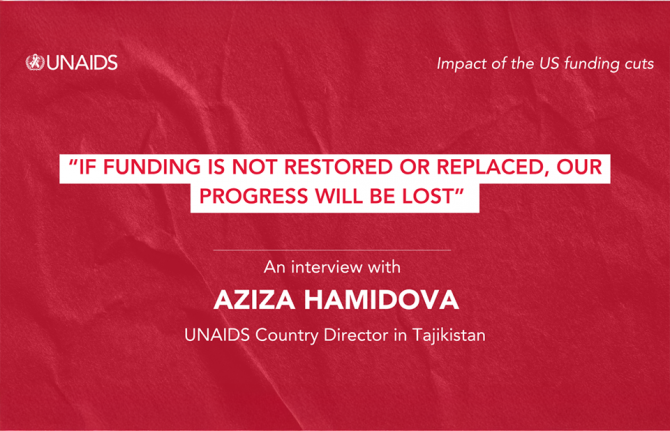
Feature Story
“If funding is not restored or replaced, our progress will be lost” - UNAIDS Country Director in Tajikistan amid funding cuts for the HIV response
29 May 2025
29 May 2025 29 May 2025As international funding declines, countries reliant on global support to fight HIV are being forced to adapt, and fast. In Tajikistan, the impact of these changes is already being felt. We spoke with Aziza Hamidova, UNAIDS Country Director in Tajikistan, about the country’s achievements over the years, the immediate impact of US funding cuts, and what is at stake for the most vulnerable communities.
Q: How would you describe the progress Tajikistan has made in its HIV response before the recent US funding cuts?
Tajikistan has made significant progress in its HIV response over recent years. Since 2020, HIV-related mortality has halved. Programmatic data on vertical transmission rates among women in care, suggests the rates have dropped from 2.6% in 2018 to just 0.8% in 2024, with only one case registered this year. Blood transfusion safety has been flawless for nearly 22 years, thanks to efforts by the Global Fund, UNAIDS, and other partners. Antiretroviral treatment costs have also been dramatically reduced—from US $254 to under US $65 per year—due to partnerships with PEPFAR, the Global Fund, and UNAIDS. Antiretroviral therapy is now available to all people living with HIV in the country. Outreach and awareness programmes, particularly for key populations such as people who inject drugs, men who have sex with men, sex workers, young people, and women living with HIV, have ensured good treatment coverage and testing rates. Pre-exposure prophylaxis (PrEP-medicine to prevent HIV) had also been available and promoted through civil society organizations. Importantly, community-led monitoring had become a critical, institutionalized part of the national HIV programme.
Q: What immediate impacts have the US funding cuts had on Tajikistan’s HIV response?
While the provision of basic HIV services, including testing and treatment at state healthcare facilities, has not been significantly affected—thanks mainly to Global Fund support—there have been notable reductions in outreach and access to services for key populations. PEPFAR’s investments have been crucial in improving the quality and reach of these services. As a result of the funding cuts, outreach, access to PrEP, testing, and counselling have all diminished. Two highly popular community health centres, known for providing stigma-free services, have closed, and community services for key population groups served by these centres have been completely stopped. Community-led monitoring, a vital mechanism for ensuring programme impact and accountability, has also been discontinued.
Q: What are you hearing from communities directly affected by these closures and service reductions?
Our partners and beneficiaries are reporting the suspension of awareness work, interruptions in comprehensive support programmes, and worsening mental health. We have observed a decreased adherence to antiretroviral therapy, particularly among clients who previously relied on community-led organizations or health centres. Many individuals who were on PrEP no longer feel safe or supported and have dropped out of the programme.
In addition, skilled professionals who provided these services have faced emotional burnout and job instability, with some leaving the sector altogether. Community-led organizations that lost funding for community-led monitoring are now unable to participate meaningfully in advocacy and policymaking or the implementation of the national HIV programme.
Although PEPFAR funding for community health centres and outreach was temporarily restored at the end of April, we are still seeing reduced rates of testing and client engagement, with a number of clients lost to follow-up.
Q: How have the government and partners responded to the funding cuts, and what is UNAIDS doing to support them?
Tajikistan never planned to remain dependent on external support indefinitely.
In 2024, with UNAIDS support, the country conducted a National AIDS Spending Assessment assessment, revealing that over 60% of the national HIV programme was funded externally, mainly by the Global Fund and the US government. In response, the government, with support from UNAIDS, PEPFAR, and the Global Fund, developed its first HIV Sustainability Roadmap, aiming for national programme sustainability by 2030. The abrupt funding interruption was a shock to all stakeholders, prompting emergency actions by the government. Strategic prioritization is now underway with the support of UNAIDS, and while additional state budget funding has been allocated for 2026, it remains insufficient. Mobilizing further external resources, especially for key populations, is still necessary.
Q: What would happen if US funding is not restored or replaced?
If US funding is not restored or replaced, Tajikistan would be set to lose about 60% of its HIV programme funding. This would risk the progress that we all worked so hard for, potentially returning the country to a time when access to testing and treatment was limited. Disruptions in prevention, testing, treatment, and care would occur, and gains achieved over years of dedicated work could quickly unravel. The most vulnerable populations would be at greatest risk, and the overall effectiveness of the national HIV response would be severely compromised.
Q: What message do you have for the international community?
The HIV response in Tajikistan, as in many countries, is a testament to the power of global solidarity and smart investments. Collective action by donors, governments, organizations, communities and civil society has saved millions of lives. Now, when we are so close to the 2030 goal of ending AIDS, this solidarity must not falter. Continued support is essential to preserve progress and prevent a reversal of the gains made.
The Joint United Nations Programme on HIV/AIDS (UNAIDS) leads the global effort to end AIDS as a public health threat by 2030 as part of the Sustainable Development Goals.
Following the US funding cuts in January, UNAIDS is working closely with governments and partners in affected countries to ensure that all people living with or affected by HIV continue to access life-saving services. For the latest updates, please visit unaids.org
Related resources
Watch: Humanity can do great things when united!
Watch: Funding cuts came as a complete shock, says Aziza Hamidova
Region/country

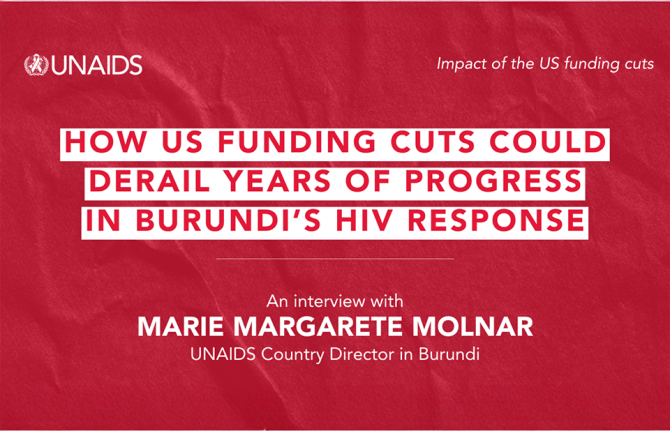
Feature Story
How US funding cuts could derail years of progress in Burundi’s HIV response
14 May 2025
14 May 2025 14 May 2025Q&A with UNAIDS Country Director in Burundi
International aid is shrinking, and countries are increasingly burdened by the need to prioritize debt repayment over essential services, including healthcare. This shift has left vulnerable populations more exposed, with the abrupt funding cuts by the United States throwing the HIV response in many countries into chaos. Burundi, unfortunately, is no exception. Across the country, HIV services have faced severe disruptions. Clinics are reducing their services, staff are being laid off, and thousands of people living with HIV are at risk of losing access to critical treatment.
In this interview, Marie Margarete Molnar, UNAIDS Country Director in Burundi, explains how communities are being affected, how the health system is coping, and what must happen next.
Q: Can you describe the current funding landscape for Burundi’s HIV response?
Burundi’s HIV response relies heavily on international aid - 95% of its funding comes from donors, with the US government contributing 51% through PEPFAR. This support sustained 10 major projects covering HIV prevention, treatment, and care for both the general population and vulnerable populations. PEPFAR also provided support to community-led monitoring projects and critical data system information.
Q: How have the recent US funding cuts affected these programmes?
Out of the 10 PEPFAR-funded projects, three were not eligible for the US waiver and had to stop operating. Some of the remaining seven, although eligible, could not resume their activities due to delays and financial uncertainty. As a result and based on an assessment conducted during the first month of the pause, at least 10 000 people living with HIV—who were among the 79 000 currently under treatment—have been directly affected. These individuals risk losing consistent access to medication and support services. In addition, 167 health professionals have lost their positions. These include doctors, nurses, psychologists, lab technicians, and community health workers—many of whom were directly providing HIV services. Financially, the immediate PEPFAR cut represents approximately US$ 6.5 million from the annual PEPFAR envelope of US$ 25 million for HIV in Burundi.
Q: What does this mean in practical terms for people on the ground?
Burundi had almost reached the 2025 ambitious targets: 95% of people living with HIV who know their HIV status, of whom 95% are on treatment and of the people on treatment 95% are virally suppressed. This was the result of strong collaboration between the government, civil society organizations and partners. The country was even recognized with an award. But now the third 95, on viral suppression, is declining because some people can no longer access viral load testing or follow-up services. If the situation continues, there is a high risk of an increase in new infections and a weakening of the entire HIV response system.
Q: What steps have the government and partners taken so far to respond to the crisis?
The government and partners acted quickly. UNAIDS conducted consultations during the first two weeks of February with key stakeholders. These consultations identified the scale of the impact and led to a series of recommendations that were shared with the Government and partners. The Ministry of Health together with UNAIDS and WHO held a two-day workshop with the PEPFAR implementing partners and civil society to understand how the cuts affected budgets, staffing, services, and beneficiaries and to brainstorm on rapid mitigation measures. As instances, it was recommended carrying out field missions to visit treatment sites and assess how services were coping without US support, forming a crisis response group and developing a national contingency plan. The government also began to identify treatment sites facing ARV shortages and organized a drug quantification workshop after PEPFAR-supported partners could no longer lead it.
Finalizing the HIV Sustainability Roadmap has also become a top priority. The roadmap is intended to guide how Burundi can finance and manage its HIV response without relying so heavily on external donors. We also discussed modeling different scenarios, from best case to worst case, based on whether funding returns or disappears entirely. These models would help us plan, reprioritize, and adapt strategies accordingly. We are also using the UNAIDS Rapid AIDS Financing Tool (RAFT) to get detailed data on how the funding cut is affecting commodities and staffing across the country.
Q: Is the government prepared to increase its contribution to its national HIV efforts?
It’s trying. Previously, funding for antiretroviral treatment was split between 76% from the Global Fund, 15% from the government, and 9% from PEPFAR. The government has now committed to covering partially that missing 9%. That shows political will. But it’s not just about medicine. It’s about health workers, community programmes and lab capacity. Burundi will need to restructure its approach by, for instance, integrating HIV into broader health and social protection systems, and significantly increase domestic health funding to reduce dependency, but this is difficult given the country's economic constraints.
Q: What’s your message to the international community?
Burundi is a fragile country facing multiple crises—economic instability, fuel shortages, emerging epidemics, and an influx of refugees from neighboring Democratic Republic of Congo. Despite these challenges, the country has made significant progress towards ending HIV, thanks to sustained investment in health including the HIV response. The risk now is losing these gains. Continued support from international partners is essential, not just for health but for the country’s overall development. At the same time, the Burundian government must increase its commitment to health funding. Only through global solidarity and strong political will can Burundi hope to end HIV by 2030.
The global community must understand that this is more than a budget line. It’s about lives, stability and global health security.
The Joint United Nations Programme on HIV/AIDS (UNAIDS) leads the global effort to end AIDS as a public health threat by 2030 as part of the Sustainable Development Goals.
Following the US stop work order in January, UNAIDS is working closely with governments and partners in affected countries to ensure that all people living with or affected by HIV continue to access life-saving services. For the latest updates, please visit unaids.org
Related resources
Watch: Sustainability now a crucial issue in the HIV response
Watch: Multiple crises affecting Burundi
Region/country
Related

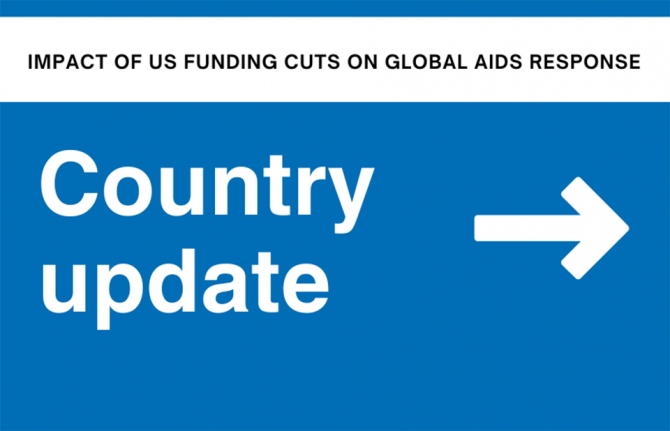
Feature Story
The impact of US funding cuts on HIV programmes in Democratic Republic of Congo
02 May 2025
02 May 2025 02 May 2025Documented impact on services
Stockouts of HIV medication and condoms are expected in the next 3-6 months.
The antenatal testing of pregnant women, delivery care for women living with HIV, early infant diagnosis and paediatric treatment services are all affected.
Data collection at some facilities/service points continues, but data quality control and data collation are affected
Human rights, key and vulnerable populations
There is disruption to PrEP services for adolescent girls and young women (AGYW), a reduced capacity of service delivery points for HIV prevention and a discontinuation of AGYW-specific outreach programs.
There is a limited availability of HIV testing services for AGYW, reduced availability of HIV prevention education and awareness campaigns, and reduction in the availability of counseling and social support services for AGYW.
All programmes on stigma and discrimination have stopped with key populations, AGYW, young people, people living with HIV and other populations affected.
Government convening, mitigation measures
The Ministry of Health has been convening impact assessment meetings, with a special commission set up for this purpose.
The ministry of justice has been leading an impact assessment on human rights violations and the protection of key populations. There have been consultations between the Ministry and organizations representing key populations.
The Ministry of Family and Child’s gender working group has conducted an assessment and a gender-based contingency plan is available.
Civil society impact, resilience and response
Civil society organizations in Haut-Katanga have conducted a risk assessment. Steps are also being taken to set up a public-private partnership with civil society organizations. Advocacy for the mobilization of local resources is underway.
Community-led organizations are at risk of closure or severe reduction in services.
There is an increased difficulty in accessing government or donor support, loss of funding for monitoring activities and a reduced ability to collect and report data.
The involvement of community-led organizations in policy design, advocacy, and work on societal enablers has been affected, resulting in a limited ability to advocate for key issues, a shift in focus due to funding constraints, and a reduced participation in policy discussions.
Service delivery by community-led organizations has been affected by the reduction or suspension of services, with an increased demand with fewer resources, loss of staff or funding cuts.
UNAIDS response
The MPox/HIV project for key populations is underway with partners in Kinshasa.
There is support for resource mobilization with a 2-year Department of Health project.
Support is being provided to the Ministry in charge of Gender and the Ministry of Human Development for the organization of a national HIV forum and mobilization of resources.
Advocacy with German and Canadian embassies, African Development Bank, World Bank and the EU to position the HIV response.
Data support is also being provided to assess the impact of the funding cuts on new HIV infections and AIDS-related deaths.
Related resources
Region/country
Related


Feature Story
Impact of US funding cuts on HIV programmes in Ukraine
22 April 2025
22 April 2025 22 April 2025Current implementation and disruptions
Documented impact on services
Due to the suspension of US-funded antiretroviral deliveries, critical gaps in ARV availability are expected as early as Q2 2025 for patients in ABC/3TC regimen.
Abacavir/Lamivudine 600/300 mg (ABC/3TC): The availability of the medication is approaching a critically low level. There are potential risks of a shortage of this medicine. The available supply will cover approximately 3.2 months (as of 01 March 2025), which means a stockout is expected by June 2025. The supply under COP23 that included the delivery of 229 packs was blocked. The delivery date to the country is currently unknown.
Lamivudine oral solution, 10 mg/ml (240 ml) 3TC fl: Delivery of 2,364 bottles for children was suspended, with no national procurement planned for 2026. Considering the expiry date of the majority of the remaining stock (June 2026), the treatment coverage is 16 months. The information is provided without considering the use of the medicine for PMTCT.
Nevirapine oral suspension 50 mg/5 ml (100 ml) NVP fl – the supply of 617 bottles is suspended. The treatment coverage with available stock is 15.4 months.
Raltegravir 100 mg (60 tablets) RAL 100mg – supply of 641 packs suspended. At the end of 2024, part of the ARV supply procured under COP23 with PEPFAR funding—579 packs (34,740 tablets)—was distributed to the oblasts. As patient enrollment and treatment optimization progress, the supply coverage will change. Considering the expiry date of the majority of the remaining stock (November 2026), the current supply coverage is 21 months.
Raltegravir 400 mg (60 tablets) RAL 400mg – the distribution of 3,471 packs to the regions is ongoing but will finish soon. Optimization based on treatment regimens using this ARV is underway, and new patients are also being initiated on therapy. Since the expiry date of most of the remaining ARV stock is set for 30 April 2026, the estimated stock coverage is approximately 14 months.
Tenofovir/Lamivudine/Dolutegravir 300 mg/300 mg/50 mg (90 tablets) TLD – In mid-March 2025, 168,397 packs of ARVs (15,155,730 tablets) procured under COP23 with US funding were delivered to the national logistics warehouse. The medicine is currently undergoing inventory control and is being prepared for distribution to the oblasts. The overall national supply coverage will amount to 9.4 months. A buffer stock of 41,273 packs (3,714,570 tablets) remains at the logistics warehouse.
Immediate Risk: Starting from April–May 2025, 193 patients out of 117473 patients on Abacavir/Lamivudine 600/300 mg (ABC/3TC) regime may face treatment interruption.
Collapse of PrEP Scale-Up and Discontinuation of Pilot CAB-LA Programs: In 2025, the PrEP program is at high risk due to halted procurement. The total stock of Tenofovir Disoproxil Fumarate 300 mg / Emtricitabine 200 mg, (TDF/FTC), across Ukraine amounts to 792,240 tablets. Based on the average monthly consumption of 150,346 tablets, the estimated supply coverage of TDF/FTC for PrEP is approximately 5.3 months. A request was submitted for 140,850 packs of TDF/FTC to be funded by the US. However, due to the suspension of US funding, this procurement is currently in question. An urgent procurement of the quantity requested using Global Fund resources is being considered.
CAB-LA: The injectable form of PrEP, CAB-LA, is supplied to two pilot regions: Kyiv and Lviv. The estimated supply coverage is approximately 14.5 months. Immediate Risk: Starting from Q2 2025, the country will likely face inability to initiate new PrEP users among key populations and a disruption in the continuity of prevention for over 13 thousand people already enrolled in the programme.
Breakdown of HIV rapid diagnostics: There is uncertainty about timely delivery of rapid diagnostics tests. Stock balance – 14,823 tests (including 470 tests expiring on 05 June 2025 and 14,353 tests expiring on 08 October 2025). The current stock is expected to last until August 2025. A delivery of 8,480 tests is expected in June 2025.
As of April 2025, the U.S. Government has suspended humanitarian assistance programs, including those funded by PEPFAR, which previously provided essential HIV-related commodities. This suspension has: 1) Blocked planned shipments of antiretroviral medications (ARVs), including major components of pre-exposure prophylaxis (PrEP), 2) Left pending orders under the COP24 procurement cycle in limbo — notably 140,850 packs of TDF/FTC for PrEP, which were to be funded by PEPFAR.
Direct Impact on Service Availability
Disruption of PrEP Services: The uncertainty with procurement for 140,850 packs of Tenofovir Disoproxil Fumarate / Emtricitabine (TDF/FTC) under PEPFAR funding has placed the national PrEP program at risk. The current supply is expected to be exhausted by mid-August 2025, based on average monthly consumption.
No confirmed delivery timeline is available, jeopardizing PrEP continuity for individuals at high risk of HIV infection, PWID, SW, MSM, serodiscordant couples.
Risk of ARV Shortages: Delays linked to the waiver’s absence are contributing to projected shortages of several essential ARVs, particularly:
Abacavir/Lamivudine (ABC/3TC) – with a stockout expected as early as June 2025.
Some ARVs are at risk of expiring before use, due to supply overlaps and administrative uncertainty (e.g., 4,450 packs of ABC/3TC and 8,300 packs of Ritonavir).
Risk to Diagnostics: The current stock of rapid diagnostic HIV tests is expected to last until August 2025.
Government convening, mitigation measures
The Ministry of Health (MoH), through the Public Health Center (PHC), is conducting rapid assessments of ARV, diagnostic, and PrEP stock levels to identify urgent supply gaps. Efforts are underway to reallocate existing stocks from regions with surplus to high-need areas, prioritizing children, pregnant women, and patients on second-line regimens.
The Government of Ukraine, in consultation with partners, is exploring the use of unspent budget lines and Global Fund reprogramming to cover immediate gaps.
The Global Fund Country Coordinating Mechanism (CCM) is actively reviewing budget flexibility for 2025–2026 to prioritize life-saving commodities. UNAIDS to support technically an immediate application by Ukraine to be submitted to the Pandemic Fund for which Ukraine would qualify. WHO and UNAIDS are in dialogue with partners to map regional lab capacity and support logistics to shift patient samples for central testing if needed.
This crisis has accelerated dialogue on transition and sustainability planning, including an appeal to pharmaceutical companies and medical goods manufacturers to explore the possibility of receiving commodities as free humanitarian or charitable assistance.
Civil society impact, resilience and response
In response to diagnostic test shortages, civil society organizations (CSOs) and local healthcare facilities have initiated internal redistribution of rapid HIV test kits purchased with local and regional budgets, as well as other budgetary programs.
Civil society platforms actively pushed for government and international donor action by: Submitting urgent appeals to donors for temporary humanitarian shipments of ARVs and PrEP, Coordinating with Global Fund implementers (e.g., 100% Life, Alliance for Public Health) to track deliveries rapid HIV test kits and PrEP supplies.
UN response
Advocacy for emergency procurement and resource mobilization: UNAIDS and UN partners are supporting national counterparts, including the Ministry of Health (MoH) and Public Health Center (PHC), in engaging international donors to mitigate disruptions in ARV and PrEP supplies.
UNAIDS is working with the MoH and other stakeholders to develop longer-term strategies for transition and sustainability, including Diversification of procurement sources, Programmatic optimization to prioritize high-impact interventions amid constrained resources.
Related resources
Region/country
Related
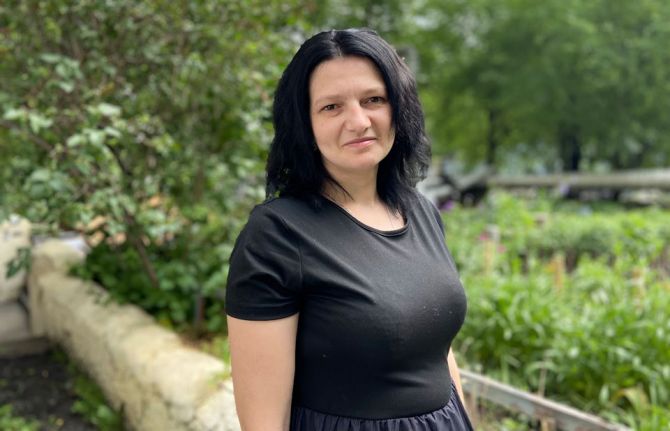 Women, HIV, and war: a triple burden
Women, HIV, and war: a triple burden

12 September 2025
 Displacement and HIV: doubly vulnerable in Ukraine
Displacement and HIV: doubly vulnerable in Ukraine

11 August 2025


Feature Story
Impact of US funding cuts on HIV programmes in South Africa
22 April 2025
22 April 2025 22 April 2025Documented impact on services
According to the Department of Health Consolidated Impact Assessment report, the three most impacted provinces regarding HIV and TB prevention services following the US funding cuts are Western Cape, Northwest and Gauteng.
The closure of key population clinics has disrupted access to routine services, including PrEP, and clients have been referred to public health facilities. The DREAMS programme and other services for adolescents and young people have also been impacted, including the mobile outreach services for high transmission areas. According to the International Treatment Preparedness Coalition, the funding cuts could compromise care in non-U districts as decision-makers have limited access to the stock visibility system (SVS) and national dashboards. The mobile application (SVS App) and web management portal (SVS Web) have been used to monitor the availability of medicines and other health commodities at over 3 000 public health clinics and over 300 hospitals since 2015.
Civil society impact, resilience and response
Community initiatives addressing HIV now hang in the balance following funding cuts. Some community-based organizations have been forced to shut down certain programmes while others have stopped operating entirely. These programs provide access to nutritious food in underserved areas, which is vital to improve children's overall treatment. Other programmes include protecting survivors of gender-based and sexual violence through provision of counselling services, HIV preventive medication and safe spaces for women.
Government actions
The Minister of Health, Dr Aaron Motsoaledi, says a new budget allocation to the Department of Health is aimed at addressing longstanding backlogs and rebuilding the country’s strained healthcare system.
The Department of Health will spend ZAR1.4 billion to urgently procure critical medical equipment, including hospital beds and other consumables which have been in short supply across many public hospitals. This is in addition to strengthening healthcare staffing levels at the cost of ZAR 1.78 billion.
Close the Gap campaign
As part of the Close the Gap Campaign, the Department of Health is aiming to reach over 600 thousand men for linkage to HIV treatment. A men’s health clinic in KwaZulu-Natal, launched as a pilot project by the Department of Health has been hailed as a groundbreaking success. Health services provided to men include standard primary healthcare, VMMC, and prostate cancer screening. There are trained male nurses specifically assigned to these dedicated sections. Feedback received indicates that men appreciate the separate space where they feel “seen and heard”. Due to demand, the project has been expanded to five other municipal clinics.
Related resources
Region/country


Feature Story
Impact of US funding cuts on HIV programmes in Malawi
15 April 2025
15 April 2025 15 April 2025Current implementation and disruptions
• Resumption of activities: As of April 7, some CDC-funded partners, including Baylor and Partners in Hope, had resumed their activities. This involves approximately 1,771 staff supported by US funding, supporting HIV service delivery across most districts. The risk that long-acting injectable PrEP might expire has been reduced with the resumption of HIV services.
• Government facilities: Operating at reduced capacity due to gaps in specific human resources for health teams previously supported by PEPFAR, with HIV testing being most affected. The Government has allocated 23.3 billion Kwacha (US$11) million to the Ministry of Health and plans to recruit 6,000 staff covered by the 2025/26 budget to help mitigate the impact of the US funding cuts. The recruited staff will be absorbed into the Government payroll. Transportation of samples is one program area that has been impacted by the US funding cuts. The Government further allocated 3 billion Kwacha (US$1.7million) towards the transportation of HIV samples. • Essential commodities: Most essential HIV commodities, including ARVs, are procured with Global Fund resources, with current funding lasting until 2027. Condom stock levels are sufficient, but distribution, especially among young people, is affected as most NGOs who supported condom distribution have stopped providing services. Cervical cancer screening remains closed and is struggling to restart.
• Emergency areas: A recent assessment of HIV response in climate related disaster emergency prone areas highlighted gaps in the HIV response, including in HIV testing, access to services for pregnant and lactating women receiving services for prevention of vertical transmission of HIV, syphilis and hepatitis services that do not receive multi-month dispensing of ARVs (including outreach service gaps), and programmes to reduce stigma and discrimination. Because of floods, some facilities and hard to replace HIV commodities have been swept away.
Documented impact on services
• Service reductions: The country has seen the closure of centres of excellence and a drastic reduction of service provision affecting service delivery. However, as of 7 April, most CDC-funded partners had been advised to resume implementation of activities, including the NGOs conducting voluntary medical male circumcisions and programs for orphans and vulnerable children (information on which partners is yet to be confirmed).
• The US funding cuts have affected various programmes, including HIV services, supply chain management, malaria programmes, family planning, and maternal and child health services. Some of the services offered by the Government are offered at minimal capacity.
• Early infant diagnosis and paediatric HIV treatment services are affected, with all facilities working at reduced capacity.
• Testing services: HIV diagnostic assistants, supported by US funding, are no longer in service, creating gaps in HIV testing across public facilities.
• Supply chain: Stocks of antiretroviral supplies, HIV, viral load, and other lab test kits are available with minimal disruption in distribution.
• Community services: Community services are also affected, as outreach services were mostly partner-supported. Public facilities are unable to cater for the logistical costs of outreach clinics because of limited funding for fuel or not enough vehicles for transport. This is hampering access to services for hard-to-reach populations and threatens to increase default rates. In addition, 18 drop-in centres with a total cohort of 7,600 patients on antiretroviral treatment and 7,000 continuing PrEP clients are open. It is not clear if the key populations team members who were transitioned to other facilities have come back to the drop-in centres that were closed, affecting service delivery to key populations. Community-led monitoring activities have stopped, and a few are starting with support from the Global Fund, Gates Foundation and GIZ.
Human rights and key populations
• Stigma and discrimination: The US funding cuts have exacerbated stigma and discrimination faced especially by key populations members who are often blamed by the wider community for the US’ withdrawal of funding. Community members fear the cessation of antiretroviral therapy provision - and negative attitudes towards them.
• Advocacy and programming: Reduced capacity among civil society organizations to continue advocacy for domestic funding and programme design, particularly for key populations.
Politically relevant updates
• Government convening: A country-level task team, including representatives from people living with HIV and key population networks, is discussing the impact on service delivery, and identifying mitigation measures.
• National AIDS Commission: The National AIDS Commission was leading the design of development of standard operating procedures for key populations, but due to the US funding cuts, this process has halted.
UN response
UNAIDS is providing technical and financial resources to assess the HIV response during emergencies in disaster-prone districts, including the impact of the US funding cuts, to inform disaster preparedness and response intervention. The assessment was completed on April 5, 2025.
It has also developed a five-year UN Joint Programme of Support to the Government of Malawi to help highlight crucial prevention and treatment interventions the Government should prioritize to help end AIDS in Malawi.
Related resources
Region/country
Related


Feature Story
Impact of US funding cuts on HIV programmes in Angola
15 April 2025
15 April 2025 15 April 2025Immediate risks and disruptions
- Loss of PEPFAR support:
- The community outreach programme is on hold while clinical services continue in the 22 clinics supported by PEPFAR (out of 880 clinics nationally providing ART) across the 4 provinces out of 21 in Angola.
- Across the country, facilities/service points delivering antiretroviral treatment are working with the same capacity. While stocks of antiretroviral supplies, HIV, viral load and other lab test kits are available, recent reports indicate challenges with distribution.
- Logistics disruptions have led to facility-level stockouts of HIV commodities, despite stock being available in regional warehouses.
- The purchase of condoms by INLS and partners, including PEPFAR and the Global Fund, has historically covered only half of the estimated need due to resource limitations. A national condom strategy is currently under development.
- PEPFAR distributed condoms in the 22 clinics they support and via outreach programmes, which are now on hold.
- There has been a disruption in the PEPFAR data collection system. Data for Q4 (September-December 2024) is still being collected and analyzed due to a lack of human resources to support DHIS2 (health logistics data) reporting. Eighteen PEPFAR-supported sites are included in the Estimation and Projection Package Spectrum model for calculating HIV incidence; however, PEPFAR antenatal care testing data was not available to serve as a benchmark against the reports submitted in DHIS2.
- Angola received PEPFAR funding for work on community-led monitoring. This has been terminated.
- PEPFAR support for stigma, discrimination and enabling legal environments has stopped.
- Government mitigation measures:
- The Government has planned mitigation measures for each of the PEPFAR programme components. The plan indicates that the national budget is suggested to cover testing, treatment and laboratory consumables, while it is suggested that community programmes should be supported by public and private institutions.
Documented impact on services
A rapid assessment of the impact of the US funding cuts on service delivery is available. As outlined by the Institute for the Fight Against HIV/AIDS (INLS), the greatest impact of the loss of US support in Angola will be felt in the quality of services, as indicated below:
- Peer education for adolescents and youth:
- In 2024, PEPFAR supported training and mentoring for 467 health professionals creating mutual support groups and peer-to-peer programmes for adolescents and youth.
- Prevention of vertical transmission of HIV:
- As of September 2024, 1,163 pregnant women living with HIV were enrolled in a programme to prevent vertical transmission of HIV in 22 health units supported by PEPFAR.
- Community support programmes for treatment, adherence and psychosocial support are on hold.
- Early infant diagnosis:
- In addition to support for early infant diagnosis in the 22 health units covered by PEPFAR, the community component of PEPFAR supported a pilot to collect blood samples in the community, which led to an increase in early infant diagnosis from 36% to 88% in health units supported by PEPFAR. The loss of community outreach undermines these lifesaving efforts.
- Clinical management for people living with HIV:
- PEPFAR supports about 6% of HIV tests in the country.
- As of September 2024, 3,609 people were newly identified as HIV-positive, with 84% enrolled on antiretroviral treatment (ART). Without US funding, lower case identification will occur, increasing the risk of transmission and health complications.
- By 2024, a total of 26,999 people living with HIV were on treatment at PEPFAR supported sites, representing about 16% of people on ART across the country
- In addition, active community outreach ensured that out of 1,007 people who interrupted treatment in the third trimester of 2024, 707 (70%) were successfully re-enrolled in treatment;
- Only in places where there is support from PEPFAR or the Global Fund (Benguela, Bié, Cuanza Sul, Huambo and Lunda Sul), is systematic community engagement effectively implemented (focused on pregnant women, children and high-risk young people); the backing of mutual support groups of people living with HIV; the provision of psychosocial support for enhanced adherence to HIV treatment, information, education and active communication on HIV prevention, including the distribution of condoms and community based testing and linkage to services.
- Strengthening the health system:
- PEPFAR has facilitated training and capacity building for HIV health workers, improving local health systems.
- Support for data collection and monitoring has reinforced health systems and enabled data-driven decision-making.
- PEPFAR is the only program that supports the evaluation of the quality of diagnosis, increasing the accuracy, effectiveness and quality of HIV testing services in the country.
Politically relevant updates
- Government convening and mitigation measures:
- The National Institute for the Fight Against AIDS (INLS) has developed a mitigation plan, proposing the national budget cover clinical staff and medical inputs for users of 13 health units supported by PEPFAR.
- Resource mobilization from public and private institutions is identified to cover community engagement and programmes.
- INLS is coordinating the mitigation measures with the Ministry of Health and the CCM.
- Civil society impact:
- Community Led Monitoring programmes have been terminated.
- Community outreach programmes, including those for youth, pregnant women, and people living with HIV, are on hold.
- Civil society organizations are struggling, and while some have alternative funding sources, most organizations are unable to continue their planned work.
- UN response:
- UNAIDS has met with networks of people living with HIV and key populations to assess emerging challenges and discuss mitigation measures.
- In collaboration with Government and civil society, plans to develop national approaches to PEPFAR-supported community-led models are underway.
Related resources
Region/country
Related


Feature Story
Impact of US funding cuts on HIV programmes in Lao PDR
14 April 2025
14 April 2025 14 April 2025Immediate risks or disruptions
- Impact on cooperative agreements:
- WHO-US CDC cooperative agreement: The WHO-US CDC cooperative agreement has been significantly impacted, particularly in provision of technical assistance to expand point-of-care services, expanding pre-exposure prophylaxis services, strengthening strategic information systems, capacity-building through training, workshops, and seminars, as well as travel and human resources-related costs.
- Ministry of Health cooperative agreement: The HIV department is partially impacted, with some planned activities not receiving full US Government approval or funding. The US funding cuts have significantly impacted maternal and child health programs, the original $400,000 commitment per year was reduced by more than 50%. This reduction has led to major challenges in capacity-building efforts, limited training opportunities for healthcare providers, and reduced plans for integrating maternal and child health services into point-of-care sites.
- WHO cooperative agreement: Fully affected, disrupting all planned activities under their Direct Financial Cooperation agreement with the government. This includes efforts to strengthen laboratory service quality, improve strategic data reporting and cover human resource- related costs.
- Service delivery:
- Routine HIV services at antiretroviral therapy sites and points of care remain largely unaffected due to the national programme’s continued provision of regular HIV testing and antiretroviral care.
- However, the US funding cuts have disrupted HIV prevention programmes, particularly those supported by PEPFAR through USAID/FHI 360 and WHO-US CDC. This has led to delays or disruptions in community-based HIV outreach programmes.
- Community impact:
- Eight staff members from the Association of People Living with HIV across 12 operational provinces will lose their jobs, further impacting service delivery and community support efforts.
- Community-led organizations have experienced a reduction or suspension of services, loss of funding, and loss of staff, reducing their ability to collect and report data and limiting their ability to reach out into the communities to provide HIV prevention services.
Politically relevant updates
- Government and international response:
- The Global Fund to Fight AIDS, Tubercuosis and Malaria (Global Fund) and the United Nations have advocated for the government to fully access and optimize the Health and Nutrition Services Access Project (HANSA) grant and loan components to bridge gaps created by the US funding cuts.
- Communities have approached the French funding mechanism L'Initiative from Expertise France to help close funding gaps.
- The UN Country Team has mapped the funding gaps and has started quantifying the reduction from the United Nations Sustainable Development Cooperation Framework (CF) as a result of the decrease in overseas development assistance. Eleven of the CF’s 21 outputs have been affected by funding reductions. Programmes affected by funding reductions account for more than a quarter of expected available funding in 2025. Outcome 1 (including Health, Nutrition and Food Security) has the most funding at risk of reduction. Outputs in Outcome 3 (Governance and Rule of Law) see the largest proportional reduction in funding.
- UNAIDS has supported the government in mapping the gap caused by the US funding cuts and has shared a report with the Global Fund and other development partners.
- UN Joint Team has mapped the impact on the Joint Programme. While the UNAIDS Cosponsors are looking for stop-gap measures to cover the gaps in the short term, the US funding cuts are expected to significantly reduce the UN’s contribution to the HIV response in Lao PDR. Since the US was the sole donor to UNODC’s health program in Lao PDR, this will result in the suspension of all UNODC health-related activities in the country as of May 1, 2025.
Civil society impact, resilience and response
- The Community-led monitoring for key populations project, implemented by the Association of People Living with HIV and supported by USAID/FHI 360, operates in Vientiane Capital, Savannakhet, and Champasak provinces. This initiative enhances community engagement among men who have sex with men and transgender individuals, strengthening their capacity to address their own health challenges while fostering trust and collaboration between communities and healthcare providers. This project has significantly improved health outcomes and reduced stigma. However, the suspension of this project is expected to hinder the expansion and scale-up of HIV community led monitoring across all key population services. The loss of eight staff members from the association of people living with HIV across 12 operational provinces will further impact service delivery and community support efforts.
- Despite these challenges, some community-led organizations are managing to sustain efforts through alternative sources of funding, demonstrating resilience and adaptability in the face of funding cuts. However, these measures may not be effective beyond 2025 and will result in weakening the inclusion of community-led efforts in the HIV response.

